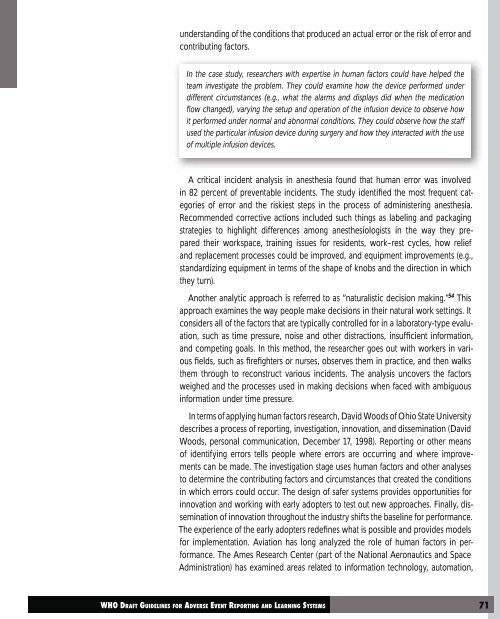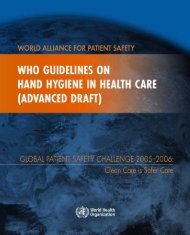Adverse event reporting.pdf
Adverse event reporting.pdf
Adverse event reporting.pdf
You also want an ePaper? Increase the reach of your titles
YUMPU automatically turns print PDFs into web optimized ePapers that Google loves.
understanding of the conditions that produced an actual error or the risk of error and<br />
contributing factors.<br />
In the case study, researchers with expertise in human factors could have helped the<br />
team investigate the problem. They could examine how the device performed under<br />
different circumstances (e.g., what the alarms and displays did when the medication<br />
flow changed), varying the setup and operation of the infusion device to observe how<br />
it performed under normal and abnormal conditions. They could observe how the staff<br />
used the particular infusion device during surgery and how they interacted with the use<br />
of multiple infusion devices.<br />
A critical incident analysis in anesthesia found that human error was involved<br />
in 82 percent of pr<strong>event</strong>able incidents. The study identified the most frequent categories<br />
of error and the riskiest steps in the process of administering anesthesia.<br />
Recommended corrective actions included such things as labeling and packaging<br />
strategies to highlight differences among anesthesiologists in the way they prepared<br />
their workspace, training issues for residents, work–rest cycles, how relief<br />
and replacement processes could be improved, and equipment improvements (e.g.,<br />
standardizing equipment in terms of the shape of knobs and the direction in which<br />
they turn).<br />
Another analytic approach is referred to as “naturalistic decision making.” 54 This<br />
approach examines the way people make decisions in their natural work settings. It<br />
considers all of the factors that are typically controlled for in a laboratory-type evaluation,<br />
such as time pressure, noise and other distractions, insufficient information,<br />
and competing goals. In this method, the researcher goes out with workers in various<br />
fields, such as firefighters or nurses, observes them in practice, and then walks<br />
them through to reconstruct various incidents. The analysis uncovers the factors<br />
weighed and the processes used in making decisions when faced with ambiguous<br />
information under time pressure.<br />
In terms of applying human factors research, David Woods of Ohio State University<br />
describes a process of <strong>reporting</strong>, investigation, innovation, and dissemination (David<br />
Woods, personal communication, December 17, 1998). Reporting or other means<br />
of identifying errors tells people where errors are occurring and where improvements<br />
can be made. The investigation stage uses human factors and other analyses<br />
to determine the contributing factors and circumstances that created the conditions<br />
in which errors could occur. The design of safer systems provides opportunities for<br />
innovation and working with early adopters to test out new approaches. Finally, dissemination<br />
of innovation throughout the industry shifts the baseline for performance.<br />
The experience of the early adopters redefines what is possible and provides models<br />
for implementation. Aviation has long analyzed the role of human factors in performance.<br />
The Ames Research Center (part of the National Aeronautics and Space<br />
Administration) has examined areas related to information technology, automation,
















